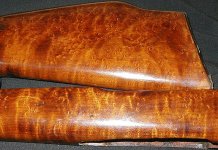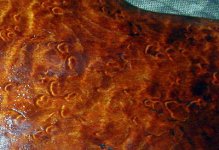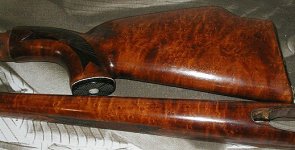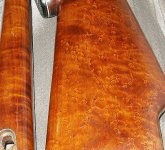my father had a method of finishing wood, birdseye in particular, that I plan on trying to adapt to a veneer.
He would bring linseed oil to just shy of a boil and then brush on dozens of coats, allowing 1 day between coats over a period of 2 weeks. After 14 coats the birdeye maple would take on a translucent appearance that would be about 1/8 inch deep. Then he would take a small tiger touch and allow the flames to brush across the surface and the most amazing transformation would take place.
Here is a gun stock that he carved and soaked the entire peice in a pot of steaming linseed oil for a week and then flame washed it. This stock is quite beat up as it was on the family deer rifle for many many years. It's to bad that photo's can't really show this type of thing.
He would bring linseed oil to just shy of a boil and then brush on dozens of coats, allowing 1 day between coats over a period of 2 weeks. After 14 coats the birdeye maple would take on a translucent appearance that would be about 1/8 inch deep. Then he would take a small tiger touch and allow the flames to brush across the surface and the most amazing transformation would take place.
Here is a gun stock that he carved and soaked the entire peice in a pot of steaming linseed oil for a week and then flame washed it. This stock is quite beat up as it was on the family deer rifle for many many years. It's to bad that photo's can't really show this type of thing.
Attachments
Probably just a mistyping. I think this is what is needed:
http://shop.store.yahoo.com/shopsourceone/tigertorch.html
BTW, that is some seriously beautiful work.
http://shop.store.yahoo.com/shopsourceone/tigertorch.html
BTW, that is some seriously beautiful work.
lol, "tiger touch"
Sounds like an ancient asian martial arts death blow.
Ya tiger torch although what he called a tiger torch is not quite the same as what it means today. It was a small brass kerosene torch that you pumped up like the old lanterns.
I think the modern version would work fine. It's what I will be using.
The important part is that its a non focused flame that you kind of wash over the wood. What happens is almost like an illusion when you see it. The grain just appears out of no where. It takes practice but it will send a thrill up your spine when you see it happen.
Thanks for the compliments. I wish I could show you the gun but thanks to the gun registery it is no more. It was polished to a chrome like finish with custom sights. He built it in our basement one winter. He scratch built a matching bowie and skinning knife to go with it the next winter. Winters are long in New Brunswick.
I don't know how well it will translate to veneer but I am looking forward to trying it this summer. If any of you try it please share with us.
Sounds like an ancient asian martial arts death blow.
Ya tiger torch although what he called a tiger torch is not quite the same as what it means today. It was a small brass kerosene torch that you pumped up like the old lanterns.
I think the modern version would work fine. It's what I will be using.
The important part is that its a non focused flame that you kind of wash over the wood. What happens is almost like an illusion when you see it. The grain just appears out of no where. It takes practice but it will send a thrill up your spine when you see it happen.
Thanks for the compliments. I wish I could show you the gun but thanks to the gun registery it is no more. It was polished to a chrome like finish with custom sights. He built it in our basement one winter. He scratch built a matching bowie and skinning knife to go with it the next winter. Winters are long in New Brunswick.
I don't know how well it will translate to veneer but I am looking forward to trying it this summer. If any of you try it please share with us.
poobah said:Binary & Guys,
I with you on the Linseed oil... you can usually buy it boiled... akin to blowing off the "foreshots"... less fusel oils I would presume.
What about the torching though? Is that done to polyrmerize/harden the finish?

Well I guess I should have delved into it a tad deeper. I wasn't sure how the post would be recieved as I am a noob here so I kept it brief.
The technique does use a boiled linseed oil but its also heated up prior to applying it. Bring it to a simmer and then back off the heat a tad and keep it there. Dad used a giant cast iron pot like we used for the family lobster boils in the summer. If the peice was small enough he would actually emerse it into the heated oil and leave it there for several days to a week with the heat applied the entire time.
If you can't emerse the piece then you thickly brush on the heated oil and allow the wood to soak as much of it as possible. You do this for as many coats and as many days as you have patience for. I remember 14 days being the minimum.
The wood will actually start to turn translucent as it soaks up the oil. It will get so clear that the grain will start to dissapear. The gun stock for example looked almost completely translucent after a week of soaking in heated oil. It looked like it was made out of plastic except there was no type of plastic that looked like that back then. It lost all of its pigmentation. It looked like crap but in a sort of neat way.
The trick was the flame. Once the peice was taken out and wiped off the flame is washed over the surface. As the flame heats the wood what you see in the photos appears out of no where. Those photos look nice but they do not give any sense of the depth that is achieved. It's like trying to take a picture of a Chip Foose paint job at a car show. Everyone that sees the pic's go wow, but they really only have a faint idea of how good it looks.
It is tricky though. Too much flame and it gets blotchy or worse. After 14 days of brushing heated oil onto rather expensive wood it kinda sux to wreck it. But the risk is worth it. People that have no interest in wood working will look at it with amazement.
Thats my goal, to amaze them before I even turn the system on and to stun them after I do.
Dryseals said:Beautiful finish, I'm woundering though about the depth of the veneer and whether or not it would do as well. I have some here at the house, I think I'll give it a try, just for fun.
I had the same thoughts as well, keep us posted.
Yes, this technique will work well with the veneers. At least as thin as 0.005". I have worked with burl veneers having severe defects... holes and splits. In these cases, I would putty and paint in artificial wood grain with laquers. When done right, the "depth" would remain. "Depth" in finishes, like paintings, is really an illusion; but a very pleasant one!
You would want to be very careful with the heat however. PVA will turn into liquid with the application of heat! Come to think of it; I would try a test piece to make sure the veneer remained bonded.

You would want to be very careful with the heat however. PVA will turn into liquid with the application of heat! Come to think of it; I would try a test piece to make sure the veneer remained bonded.

poobah said:Yes, this technique will work well with the veneers. At least as thin as 0.005". I have worked with burl veneers having severe defects... holes and splits. In these cases, I would putty and paint in artificial wood grain with laquers. When done right, the "depth" would remain. "Depth" in finishes, like paintings, is really an illusion; but a very pleasant one!
I have a great interest in working with burls and of course large sheets always contain some defects and often the wilder the burl the greater the defects. I wish to play with crotch patterns as well and they often suffer from similiar problems.
I am an artist by nature and had planned on filling and painting but I have no source of reference and no one to talk to about it. I come from a long line of craftsmen but they have all passed on. I remember many of the techniques because I grew up in that environment but due to a youth filled with alcohol and drugs they never had a chance to formally teach me anything. I am pleased to hear that if the painting and filling is done right it looks right.
I feel that veneers will not require as many coats and in fact I doubt that the solid peices that dad worked with required nearly so much effort. He followed the teachings as they passed down though the generations and he was a perfectionist.
Is it your experience that it doesn't take as much effort as the process I explained? Are you a very experienced in this type of thing?
Hey Binary,
I used to do the kind of burl stuff you would see in old Mercedes and such... lotsa compound curves and all. I am glad you didn't "get all subjective" on me when I said "depth" was an illusion.
If you're an artist you have one up on me... I can do art... but it don't come easy... it all looks "engineered".
If there is interest here on the forum we could do it here. Otherwise send me a PM and I'll be glad to tell you what I know. I did burl before the age-of-internet and as such, I am largely self taught. I wouldn't dare call myself an expert, but I can teach how to put burl on a golf ball... So much is about "feel" you will wind up being self taught ultimately anyway...
BTW... when you buy slices of real burl, not butterflied and paperbacked, it literally looks like an egg crate... angry wood.
I am still waiting for a chemist to come along and tell us why the flame thing works out so cool... I have never "done it" but I can just imagine. I think it is about "natural" polymerization...
SY... it's purported you're a chemy...right?
Right on with the drugs and alcohol... we all did it... or lied... or died.
Keep in mind, your dad's methods were very sound. His fathers methods were based on preservation and quality, the beauty was a bonus I would imagine. My grandfather kept a can of mineral oil in the shop... he would kick my bahuna, and me out of the shop, if I put away a tool without a rubdown... same guy taught me how to sharpen a chisel (smart old sot) BEFORE he would let me use one!

I used to do the kind of burl stuff you would see in old Mercedes and such... lotsa compound curves and all. I am glad you didn't "get all subjective" on me when I said "depth" was an illusion.
If you're an artist you have one up on me... I can do art... but it don't come easy... it all looks "engineered".
If there is interest here on the forum we could do it here. Otherwise send me a PM and I'll be glad to tell you what I know. I did burl before the age-of-internet and as such, I am largely self taught. I wouldn't dare call myself an expert, but I can teach how to put burl on a golf ball... So much is about "feel" you will wind up being self taught ultimately anyway...
BTW... when you buy slices of real burl, not butterflied and paperbacked, it literally looks like an egg crate... angry wood.
I am still waiting for a chemist to come along and tell us why the flame thing works out so cool... I have never "done it" but I can just imagine. I think it is about "natural" polymerization...
SY... it's purported you're a chemy...right?
Right on with the drugs and alcohol... we all did it... or lied... or died.
Keep in mind, your dad's methods were very sound. His fathers methods were based on preservation and quality, the beauty was a bonus I would imagine. My grandfather kept a can of mineral oil in the shop... he would kick my bahuna, and me out of the shop, if I put away a tool without a rubdown... same guy taught me how to sharpen a chisel (smart old sot) BEFORE he would let me use one!
well I'd be most appreciative if you would share with us and I am grateful for a mod giving it the nod.
I have lurked on audio forums for years and have seen precious few discussions on speaker building as an artform. The math and numbers don't mean much to me cept as a basic guidline.
A truly exceptional speaker is a rare thing. If we are lucky enough to create something that does what we hoped, the least we can do is make it look as stunning as our ability allows.
I talk a lot but I listen as well.
I have lurked on audio forums for years and have seen precious few discussions on speaker building as an artform. The math and numbers don't mean much to me cept as a basic guidline.
A truly exceptional speaker is a rare thing. If we are lucky enough to create something that does what we hoped, the least we can do is make it look as stunning as our ability allows.
I talk a lot but I listen as well.
- Status
- This old topic is closed. If you want to reopen this topic, contact a moderator using the "Report Post" button.
- Home
- Loudspeakers
- Multi-Way
- A lost method of finishing



